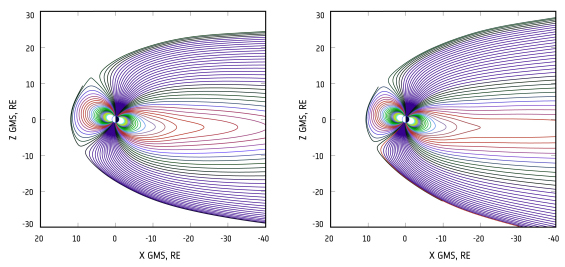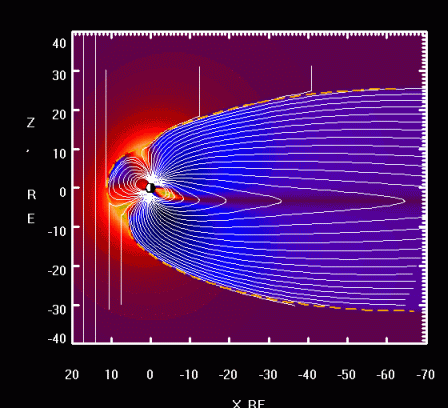Cluster helps to model Earth's mysterious magnetosphere
7 May 2014
For many years, scientists have been striving to understand the constantly changing structure and behaviour of the huge magnetic bubble that surrounds our planet. One approach – pioneered by Russian scientist Nikolai Tsyganenko - has been to develop models based on data sent back by spacecraft, such as ESA's Cluster quartet.As Earth sweeps around the Sun, it is constantly bombarded by energetic particles from solar storms and deep space. Fortunately, the planet generates a powerful magnetic field which largely shields the atmosphere and surface against this perpetual, but variable, assault.
At the same time, the magnetosphere serves as a huge reservoir, storing energy which is pumped in from the solar wind and then released into near-Earth space and the upper atmosphere during magnetic storms.
As humankind becomes more and more dependent on space technologies, it becomes increasingly important to be able to map the terrestrial magnetosphere accurately and predict its dynamics, using all available data from spacecraft and ground-based observatories. In this sense, models of the magnetosphere play the same role as maps drawn up by early explorers when they encountered new, uncharted lands.
Over recent decades, two approaches have been developed in an effort to improve our understanding of how the magnetised gas of the solar wind interacts with the geomagnetic field. One is a purely theoretical approach, which relies on the power of supercomputers and sophisticated numerical methods, modified by simplifying assumptions made along the way.
The other approach – developed by Nikolai Tsyganenko and others - is based on direct observations by spacecraft. In essence, this approach involves a description of the global magnetic field and its responses to interactions with the solar wind by developing a model that provides the best agreement with spacecraft data.
A principal problem is that the magnetosphere is a highly variable system, and the most important task of the modelling is to reproduce its dynamics during stormy space weather events. In particular, there is often an extreme disparity between the enormous multitude of possible geomagnetic disturbances and the fact that the huge magnetosphere is being monitored by only a few spacecraft.
On the other hand, five decades of space missions have produced enormous amounts of archived data, and a whole suite of so-called empirical models have already been developed on that basis. Recent and ongoing multi-spacecraft missions, such as Cluster, keep adding a flood of valuable new data. In most cases, their observations are supported by simultaneous data from solar wind probes and ground-based geomagnetic observatories.
Taking advantage of the latest space missions, Tsyganenko has published the first results of data-based modelling of Earth's magnetic field based on information sent back by the Cluster, Polar, Geotail and THEMIS spacecraft during the period 1995–2012. His recent paper in the Journal of Geophysical Research: Space Physics analyses solar wind – magnetosphere interactions covering 123 geomagnetic storms.
"Most of the spacecraft that contributed to the existing archived database covered the near-equatorial part of the magnetosphere, where most of the electric currents flow," said Nikolai Tsyganenko. "However, to construct a global model one also needs observations made in high-latitude geospace, including the dayside polar cusps, where solar wind plasma penetrates the magnetosphere.
"The Cluster mission is an especially valuable source of data, owing to its multi-year long operation period, high orbital inclination, and its ability to resolve the fine structure of electric currents, owing to the specially designed constellation of four spacecraft, flying in close proximity of each other."
"Thanks to the Cluster Science Data System and the Cluster Active Archive, which provide easy access to the best calibrated Cluster data, such essential models can be produced to support magnetospheric physicists worldwide," said Philippe Escoubet, ESA's Cluster Project Scientist.
Background information
The model described in this article is reported in "Data-based modeling of the geomagnetosphere with an IMF-dependent magnetopause" by Nikolai Tsyganenko, published online in the Journal of Geophysical Research: Space Physics on 23 January 2014 (doi: 10.1002/2013JA019346).
Cluster is a constellation of four spacecraft flying in formation around Earth. It is the first space mission able to study, in three dimensions, the natural physical processes occurring within and in the near vicinity of the Earth's magnetosphere. Launched in 2000, it is composed of four identical spacecraft orbiting the Earth in a pyramidal configuration, along a nominal polar orbit of 4 × 19.6 Earth radii (1 Earth radius = 6380 km). Cluster's payload consists of state-of-the-art plasma instrumentation to measure electric and magnetic fields over wide frequency ranges, and key physical parameters characterising electrons and ions from energies of near 0 eV to a few MeV. The science operations are coordinated by the Joint Science Operations Centre (JSOC) at the Rutherford Appleton Laboratory, United Kingdom, and implemented by ESA's European Space Operations Centre (ESOC), in Darmstadt, Germany.
The Cluster Science Data System is a set of nationally distributed data centres, which generate and maintain selected data sets for the experiments most closely associated with each centre.
The Cluster Active Archive is the depository of processed and validated Cluster data, raw data, processing software, calibration data, documentation and other value-added products. All of the Cluster data are public domain.
Contact
Nikolai Tsyganenko
Department of the Earth Physics
Institute and Faculty of Physics
Saint Petersburg State University
Saint Petersburg, Russia
E-mail: n.tsyganenko![]() spbu.ru
spbu.ru
Philippe Escoubet
Cluster Project Scientist
Scientific Support Office
Directorate of Science & Robotic Exploration
ESA, The Netherlands
Phone: +31-71-565-3454
E-mail: Philippe.Escoubet![]() esa.int
esa.int




